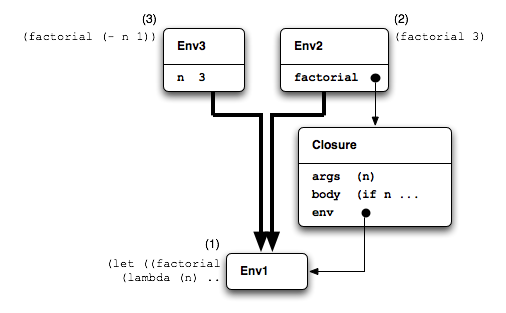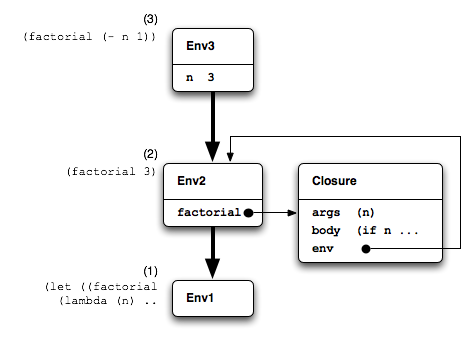
letrecLet's try a little experiment with the interpreter version 0.0.2.
We'll try to use let to define a recursive function, the
perennial factorial function16.
> (let ((factorial > (lambda (n) > (if n > (* n (factorial (- n 1))) > 1)))) > (factorial 3)) Error: no binding for factorial in PScm::Env
It didn't work. The reason that it didn't work is obvious,
considering how let works.
let evaluates the expression half of its bindings in the enclosing environment,
before it binds the values to the symbols in a new environment,
so it is the enclosing environment (the global environment
in this case) that the lambda captures.
Now that environment doesn't have a binding for
factorial, factorial is only visible within
the body of the let, so any recursive call to
factorial from the body of the function
(closure) is bound to fail.
Putting it another way, let will create a binding for factorial,
but only by extending the global environment after
the lambda expression has been evaluated, in the global environment,
therefore capturing the global environment.
So the error is not coming from the call to (factorial
3), it's coming from the attempted recursive call to
(factorial (- n 1)) inside the body of the factorial
definition. The environment diagram in Figure 6.1 should help to make that clear.

The let evaluates the lambda expression in the initial
environment, Env1 at (1), so that's the
environment that gets captured by the Closure. Then the let
binds the closure to the symbol factorial in an extended environment
Env2, and that's where the body of the let,
(factorial 3), gets evaluated at (2). Now after
evaluating its argument 3 in Env2, the closure
proceeds to extend the environment it captured, the global environment
Env1, with a binding of n to 3 producing
Env3. It's in Env3 that the body of the
factorial function gets evaluated at (3). Now n
has a binding in that environment, but unfortunately factorial
doesn't, so the recursive call fails.
letrecWhat we need is a variation of let that arranges to evaluate
the values for its bindings in an environment where the bindings are
already in place. Essentially the environments would appear as in Figure 6.2.

In this figure the closure has been persuaded to capture an
environment Env2 containing a binding that refers
back to the closure itself (a circular reference in effect.) In
this circumstance any recursive call to factorial from
the body of the closure would work because the closure
would have extended Env2 and its body would execute
in a context (Env3) where factorial did
have a value.
The special form we're looking for is called letrec
(short for “let recursive”) and it isn't too tricky,
although a bit of a hack. Let's first remind ourselves how
let works.
let
in that new environment.Our variant, letrec, isn't all that different. What
it does is:
Obviously if any of the values in a letrec are
expressions other than lambda expressions, and they make reference
to other letrec values in the same scope, then there
will be problems. Remember that all lambda does is to capture
the current environment along with formal arguments and function
body. It does not immediately evaluate anything in that captured environment.
For that reason real letrec implementations may typically
only allow lambda expressions as values. PScheme doesn't bother
making that check17.
To implement letrec then, we first need to add a
method to the environment class PScm::Env that will allow
assignment to existing bindings. Here is that method.
59 sub Assign { 60 my ($self, $symbol, $value) = @_; 61 62 if (defined(my $ref = $self->_lookup_ref($symbol))) { 63 $$ref = $value; 64 } else { 65 die "no binding for @{[$symbol->value]}", 66 " in @{[ref($self)]}\n"; 67 } 68 }
Assign() uses a helper function _lookup_ref()
to actually do the symbol lookup. If _lookup_ref() finds
a binding, then Assign() puts the new value in place through
the reference that _lookup_ref() returns. It is an error
if there's not currently such a symbol in the environment. This
makes sense because it keeps the distinction between variable binding
and assignment clear: variable binding creates a new binding;
assignment changes an existing one.
_lookup_ref()
is simple enough, it does pretty much what LookUp() does,
except it returns a reference to what it finds, and returns undef,
rather than die()-ing if it doesn't find a value:
70 sub _lookup_ref { 71 my ($self, $symbol) = @_; 72 73 if (exists($self->{bindings}{ $symbol->value })) { 74 return \$self->{bindings}{ $symbol->value }; 75 } elsif ($self->{parent}) { 76 return $self->{parent}->_lookup_ref($symbol); 77 } else { 78 return undef; 79 } 80 }
Incidentally, LookUp() itself has been modified and
simplified to make use of it.
48 sub LookUp { 49 my ($self, $symbol) = @_; 50 51 if (defined(my $ref = $self->_lookup_ref($symbol))) { 52 return $$ref; 53 } else { 54 die "no binding for @{[$symbol->value]}", 55 " in @{[ref($self)]}\n"; 56 } 57 }
All that remains to be done is to add a LetRec subclass of
PScm::SpecialForm with an Apply() method that
implements the algorithm we've discussed, then add a binding in the
initial environment from “letrec” to an instance of that
class.
We can simplify things a bit by subclassing PScm::SpecialForm::Let
instead of PScm::SpecialForm, and factoring common code out of
PScm::SpecialForm::Let's Apply() method into a new UnPack()
method in that class. So first here's the new version of
PScm::SpecialForm::Let::Apply()
12 sub Apply { 13 my ($self, $form, $env) = @_; 14 15 my ($ra_symbols, $ra_values, $body) = $self->UnPack($form, $env); 16 17 return $body->Eval($env->Extend($ra_symbols, $ra_values)); 18 }
The common code in PScm::SpecialForm::Let::UnPack() just
unpacks the symbols, bindings and body from the argument $form
and returns them:
20 sub UnPack { 21 my ($self, $form, $env) = @_; 22 23 my ($bindings, $body) = $form->value; 24 my (@symbols, @values); 25 26 foreach my $binding ($bindings->value) { 27 my ($symbol, $value) = $binding->value; 28 push @symbols, $symbol; 29 push @values, $value; 30 } 31 32 return (\@symbols, \@values, $body); 33 }
Now, our new Apply() in PScm::SpecialForm::LetRec
makes use of that same UnPack() method (by inheriting
from PScm::SpecialForm::Let). It differs from the
original Apply() only in that it calls the environment's
ExtendRecursively() method, rather than Extend().
36 package PScm::SpecialForm::LetRec; 37 38 use base qw(PScm::SpecialForm::Let); 39 40 sub Apply { 41 my ($self, $form, $env) = @_; 42 43 my ($ra_symbols, $ra_values, $body) = $self->UnPack($form, $env); 44 45 return $body->Eval( 46 $env->ExtendRecursively($ra_symbols, $ra_values)); 47 }
So we need to take a look at that ExtendRecursively()
method in PScm::Env.
31 sub ExtendRecursively { 32 my ($self, $ra_symbols, $ra_values) = @_; 33 34 my $newenv = $self->ExtendUnevaluated($ra_symbols, $ra_values); 35 $newenv->_eval_values(); 36 return $newenv; 37 }
It creates a new environment by extending the current environment,
$self with the symbols bound to their unevaluated values.
Then it calls a new, private method _eval_values() on
the new environment. Here's that method:
39 sub _eval_values { 40 my ($self) = @_; 41 map { 42 $self->{bindings}{$_} = 43 $self->{bindings}{$_}->Eval($self) 44 } 45 keys %{ $self->{bindings} }; 46 }
All that does is to loop over all of its bindings, replacing
the unevaluated expression with the result of evaluating the expression
in the current environment. Since all of those expressions are expected
to be lambda expressions, the resulting closures capture the environment
that they are themselves bound in. QED.
A careful reader may have realised that a valid
alternative implementation of letrec would just create an
empty environment extension, then populate the environment afterwards
with an alternative version of Assign() which did not require
the symbols to pre-exist in the environment. The main reason it is not
done that way is that the current behaviour of Assign()
is more appropriate for later extensions to the interpreter.
Just to be complete, here's the new version of
PScm::ReadEvalPrint() with the binding for letrec.
31 sub ReadEvalPrint { 32 my ($infh, $outfh) = @_; 33 34 $outfh ||= new FileHandle(">-"); 35 my $reader = new PScm::Read($infh); 36 while (defined(my $expr = $reader->Read)) { 37 my $result = $expr->Eval( 38 new PScm::Env( 39 let => new PScm::SpecialForm::Let(), 40 '*' => new PScm::Primitive::Multiply(), 41 '-' => new PScm::Primitive::Subtract(), 42 if => new PScm::SpecialForm::If(), 43 lambda => new PScm::SpecialForm::Lambda(), 44 letrec => new PScm::SpecialForm::LetRec(), 45 ) 46 ); 47 $result->Print($outfh); 48 } 49 }
Let evaluates the values of its bindings in the enclosing
environment. Then it creates an extended environment with each symbol
bound to its value, in which to
evaluate the body of the let expression. This means that
recursive lambda expressions defined by let
won't work, because there's not yet a binding for the recursive function
when the lambda expression is evaluated to create the closure. In order to
get recursion to work, we needed to create a variant of let,
called letrec (let recursive) which sets up
a dummy environment with stub values for the symbols in which to
evaluate the lambda expressions, so that the lambda
expressions could capture that environment in their resulting
closures. Having evaluated those expressions, letrec
assigns their values to the existing bindings in the new environment,
replacing the dummy values. Thus when the closure executes later,
the environment it has captured, and which it will extend with its
formal arguments bound to actual values, will contain a reference
to the closure itself, so a recursive call is successful.
The tests for the letrec form are in t/PScm_Letrec.t
which you can see in Listing 14.
t/PScm_Letrec.t1 use strict; 2 use warnings; 3 use Test::More; 4 use lib './t/lib'; 5 use PScm::Test tests => 4; 6 7 BEGIN { use_ok('PScm') } 8 9 ok( 10 !defined(eval { 11 evaluate(<<EOF) }), 'let does not support recursion'); 12 (let ((factorial 13 (lambda (n) 14 (if n (* n (factorial (- n 1))) 15 1)))) 16 (factorial 4)) 17 EOF 18 19 is($@, "no binding for factorial in PScm::Env\n", 20 'let does not support recursion [2]'); 21 22 eval_ok(<<EOF, "24", 'letrec and recursion'); 23 (letrec ((factorial 24 (lambda (n) 25 (if n (* n (factorial (- n 1))) 26 1)))) 27 (factorial 4)) 28 EOF 29 30 # vim: ft=perl
There are three tests. The first two,
just prove what we already know, that let
does not (and should not) support recursion. The other new test
replaces let with letrec
and proves that letrec on the other hand does support
recursive function definitions.
Full source code for this version of the interpreter is available athttp://billhails.net/Book/releases/PScm-0.0.3.tgz